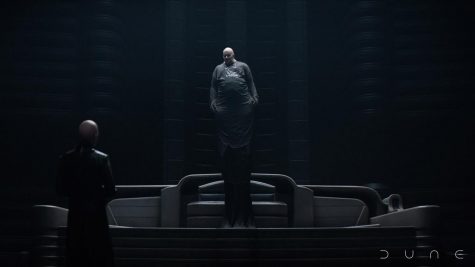More of a fantasy-based hero’s journey than a science fiction piece, Oscar-winning director Denis Villeneuve tackles the first half of Frank Herbert’s novel “Dune” into a film adaptation which was released in the United States on HBO Max on Oct. 21 and in theaters on Oct. 22.

Set in the year 10191, royalty Paul Atreides (played by Timothée Chalamet), the son of Duke Leto Atreides (played by Oscar Issac) of House Atreides, and his people take control of the planet Arrakis from the House Harkonnen by decree of the Emperor, who rules the universe. Pilot Duncan Idaho (played by Jason Momoa) and weapons master Gurney Halleck (played by Josh Brolin) mentor Paul so that he can become his father’s successor. A desolate desert planet inhabited by bedouin-esque natives named the Fremen and monstrous sandworms, Arrakis has only one resource to offer to outworlders: the Spice. Only found on Arrakis, Spice, a glittery powder used for interstellar travel, is the most valuable resource in the universe.

Villeneuve’s visual storytelling is showcased in “Dune” through expansive and otherworldly environments. Unique character and costume designs, which range from the heavy, black armor of the muscular Harkonnens to the earthy tones worn by the Fremen help attribute groups to elements of their culture. Technology in the film follows a utilitarian design, as spice harvesters are depicted to be boxes on treads and flying vehicles used by the House of Atreides look like angular helicopters. To help establish scale for viewers, people are strategically placed in comparison to narrative elements to capture the enormity of sandworms or tininess of hunter-seekers, hummingbird-sized assassin drones.
Dune appeals to viewers in the musical department as well, where composer Hans Zimmer’s score tightly ties the storytelling to the visuals on screen. To push the otherworldly aspect of the premise, the score relies on synthesizers and wind instrumentation rather than classic orchestral pieces. Angelic voices break up booming percussion to build tension with character-based leitmotifs used as callbacks to previous scenes.
The film excels at delivering concise dialogue and plot details while also showcasing Paul Atreides’s character development. Villeneuve manages to keep the overall story focused around Paul’s journey, from being unsure about his ability to lead his people when the responsibility is thrusted upon him to being sure of his place in the universe. The vast expanses of “Dune’s” source material is a herculean task to unravel as the novel dives into the social and political sciences of the story’s universe, but nevertheless, the script steadily navigates complicated exposition using Paul’s interactions with others and short documentaries about Arrakis.

However, the impressive visuals and audio fail to compensate for the biases in the film’s pacing. By prioritizing atmosphere-building scenes and focusing more on Paul’s story, side characters lack depth due to limited screen time. In a story where the protagonist’s arc relies on the decisions made by others, Paul’s changing world makes little sense to viewers. Betrayals in the film seem rushed because few motives are fleshed out. If visual-heavy scenes were cut shorter and replaced with more dialogue, the audience would be able to make stronger connections with all of the characters.
With a sequel already in the works, the end of “Dune” sets up the second part of the story rather than being able to stand on its own. In what is neither a cliffhanger nor a satisfying end, the film concludes with a mere trudge through the desert after Paul makes an important decision. No amount of captivating optics and auditory bliss can mask the inherent issues with the storytelling as it fails to establish major events in the plot.
One can only hope that the lack of depth in this film will be resolved in the sequel because the ambiance of the story has already been set and more time can thus be spent on making the supporting characters more compelling.
Rating: 3/5
This story was originally published on El Estoque on November 3, 2021.




































